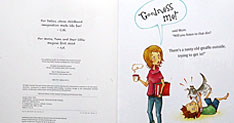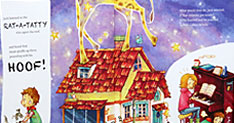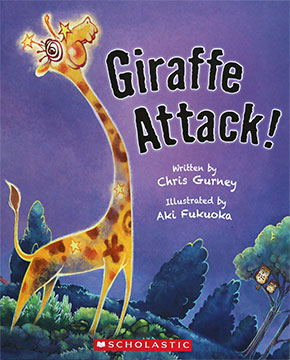
When is a giraffe not a giraffe? Jack is fearful of the dreadful 'giraffe' that everyone talks about thumping and bumping around the house trying to get in. His imagination knows no bounds, and when he is sent off to bed on his own, he is convinced the giraffe is finally going to get him. Jack hollers for his Mum and wails to her about the nasty, nippy, mean giraffe. Mum begins to laugh and tells him he is being silly. She explains to him that he has misheard and misunderstood, that it is not a GIRAFFE but a DRAUGHT that is making the house shudder and shake.
The story is told in rhythm and rhyme, with onomatopoeia used to describe the noises the 'giraffe' is making.
"Golly gosh!" said Dad, as the door went WHAM ker-BANG!
"That fierce and flustery giraffe is making things go clang!."
Jack heard the handle on the door go sneaky-creaky-clack
And raced to lock it good and tight to stop 'Giraffe Attack'!
The Story Behind the Book
This is another example of a 'truish' story, which took on a life of its own with a whole lot of imagination added.
When my son Dallas was a little boy, sometimes in the particular place we would sit to watch television, a draught, or a gust of wind would blow under the door. Someone would no doubt remark something about the draught that was coming underneath the door, or how it was making the windows rattle.
It was quite some time before we realised that in Dallas's mind, he had misheard the word 'draught' and thought we were saying 'giraffe'. Therefore, he had been picturing a real giraffe trying to get into the house by whatever means it could! He didn't seem terribly traumatised by the idea, so he may well have thought it would have been pretty cool to have a pet giraffe in the house!
There is actually a name for when you hear a word or words wrongly, and create a new meaning. Mondegreen is the word to describe mistakes our ears make. Think how many times you have misheard song lyrics, and sung your own version, only to find out later on what the real words are? That is a typical example of a mondegreen.
The story also uses a lot of onomatopoeia (a word which imitates the sound it describes). This can be used as a tool to recognise the onomatopoeia throughout, and encourage children to use it in their own stories.
Reviews
Things that go bump in the night aren't usually likened to a giraffe with clomping feet. But as is often the case with a children's books, unique storylines are what keep little fingers scrambling for more and imaginations piqued... read more
Howick and Pakuranga Times
Jack overhears members of his family talking about the fierce and flustery giraffe making things go clang, or trying to get his Grandma by the ankles, and shaking the house to its knees. Poor old Jack is terrified by the time he goes to bed. When something goes clump, thump, kerplunk on the roof he thinks the giraffe had come to get him. He hollers for help!... read more
Kids books NZ
Brilliant book! Engages the children and keeps them on the edge of their seats. This is exactly what a good story is supposed to do. What a great way to introduce the idea that imagination can get the better of you.
Use this wonderful book as a discussion tool. Talk about other words that they don't understand and tell them stories about the words you may have confused as a child. Talk about things that worry them and help them understand that life is not really so scary!... read more
KIWIreviews
Activities
Onomatopoeia is a word that imitates the sound that it describes.
An easy way for children to remember how to spell the word.
Giraffe Attack! Teaching Guide.
Giraffe Attack! Word Search.
<< back to books














